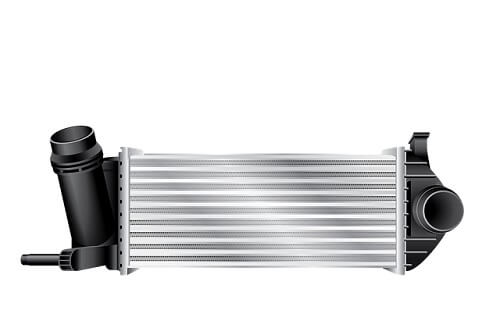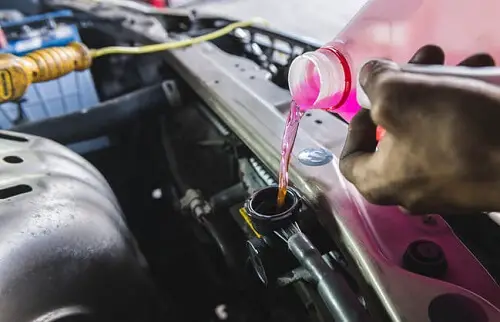
In this article, we will discuss the famous radiator “water” level. We will try to clarify what types of fluids it is convenient to use and in what proportions.
The first thing to mention is that the “water” in the radiator is not just water. It is a fluid composed of 3 things, effectively deionized water, ethylene glycol and anti-corrosion additives. Water corresponds to 50% of the mixture, and the remaining 50% corresponds to ethylene glycol and anticorrosive additives. As is known, commercial products come in ready-to-use or concentrated versions. In the latter case, dilution must be carried out in equal parts with deionized water.
The Coolant Has Three Main Functions In The Engine:
1. Coolant:
The first function is to absorb excess heat from the engine to keep the temperature of the parts in optimal ranges. Water is an excellent component in this function, so the recommendation is to use a ready-to-use product or dilute the concentrated product 50% with deionized water. Using running water can form scale deposits in the circuit due to the content of salts in it, blocking the cooling ducts and reducing the system’s performance.
2. Antifreeze:
At sub-zero temperatures, where water would freeze, the coolant must remain liquid. In this regard, an essential compound in the formulation is ethylene glycol, which lowers the freezing point and raises the boiling point, protecting high temperatures. A ready-to-use product offers excellent performance even down to -37 ° C.
3. Anticorrosive:
Anti-corrosion additive technology can be organic (OAT: Organic Acid Technology) or inorganic (IAT: Inorganic Acid Technology). When both types of additives are used, we speak of hybrid products (HOAT), such as the new Raizen Antifreeze Coolant.
The function of the additives is to protect the different metals that make up the refrigeration circuit. This inhibitor package can offer additional protection against cavitation even without adding supplemental coolant additives (SCA). Additive technology gives a name to the families of inorganic, hybrid, or organic refrigerants, which is indicated for long-life products. Shell Longlife Engine Coolant is an example of a long-life OAT coolant in a concentrated and ready-to-use form.

Read Also: Best Radiator For Jeep XJ Reviews
Frequent Asked Questions
Can I Complete The Level With Just Water?
It is not recommended. Completing the level with water only dilutes the ethylene glycol and product additives. Diluting ethylene glycol causes a worsening of the freezing and boiling point, making these values closer to pure water, depending on the amount of excess water. On the other hand, diluting the additives causes us to lose protection against corrosion in the metals of the system. In short, by adding only water, we lose thermal range and corrosion protection. It is also not correct to use a pure concentrated product since it does not have good thermal properties either (it has a worse freezing point than the diluted one). A pre-diluted and ready-to-use product should be used as we said before, or a concentrated product but diluted in equal parts with deionized water. When completing the level, it is essential not to do it hot but to let the engine cool down a bit. In this way, thermal shocks that can even cause cracks in the engine block are avoided.
Is Color Important?
In no way since the color is given by an inert colorant that does not add performance to the product. In any case, it is essential to know that traditionally organic refrigerants stain red or magenta, and inorganic products green, with exceptions to this.
What Is The Change Interval?
This is given by the manufacturer of each piece of equipment and this manual indication must be respected. Organic products will perform better than inorganic products.
Can Products Are Mixed?
In general, ethylene glycol-based coolants can be mixed. Still, it is always recommended to follow the vehicle manufacturer’s instructions and, in the long term, replace the mixes with a single homogeneous coolant.

Can I Use Water Instead Of Coolant In My Car?
There are powerful reasons why turning on the tap to cool the engine is not a good idea.
Likely, you have ever wondered if you could use water to maintain the temperature of your car’s engine. Perhaps, inspired by those old movies in which classic cars appeared with engine fumes. All it took was a little fresh water to get the radiator back to being the same as ever. The truth is that modern coolants have as little to do with water as modern cars do with old ones.
Water, yes, but not just water.
Let’s start by telling you something that will surely unsettle you: water is the best coolant there is. Current coolants can be composed, for the most part, of water, depending on their formulation.
Thus, within the composition of a refrigerant, water can represent between 45% and 70%. In contrast, MEG (mono ethylene glycol) or MPG (mono propylene glycol), which act on boiling and freezing points, can represent 25 % and 50%. The rest of the formulation corresponds to additives (between 3% and 8%).
The fact is that a cooling liquid does much more than absorb heat to lower the temperature: in addition, its boiling point must be high, to evacuate the maximum possible heat and avoid variations in the size of the parts, which would lead to wear. In this way, a greater cooling capacity of the system is also guaranteed, avoiding overheating and its derived problems.
On the other hand, the coolant should always freeze below zero degrees. The lower your freezing point, the better. This is so because the water when it freezes, increases its size, something that could cause problems and breaks inside the engine. This refrigerant must not attack the metals or rubbers that make up the cooling system.
Can You Put Water Directly Into The Radiator?
What happens if you use water to cool your car’s engine is that you are going to expose it to multiple breakdowns. This is because water is corrosive so that it can damage different elements of the cooling system.
As the water also freezes at 0ºC, below that temperature, it would increase in volume and could damage the engine. The same is true in reverse: it reaches its boiling point above 100ºC, so it will not cool the engine when it reaches higher temperatures. And then you will come across the scene of the vehicle spouting steam and smoke, which looks great in the movies but is a real nuisance in real life.
Also, bear in mind that if you do not use suitable water, problems related to algae, bacteria, calcareous salts, and other deposits can cause problems that can ruin your vehicle’s radiator.
What Do Coolants Have That Water Doesn’t?
What refrigerants have inside are ingredients that prevent all of the above from happening. That is to say MEG (mono ethylene glycol) and, where appropriate, MPG (mono propylene glycol), avoid the problems related to freezing and boiling of water since they are responsible for lowering the point at which it becomes ice and increases that from which it transforms into steam.
The glycol concentration must be adequate to protect the fluid against boiling and freezing. That is why it is so important to use quality products.
On the other hand, the additives added to the cooling liquids in their formulation fulfill several functions: they chemically stabilize the product, prevent lime deposits from hard water and other components. They also protect against the formation of foams, which hinder the conduction of heat and keep the product’s acidity within limits. There are even color additives to identify leak points in the system and others with a bitter taste to avoid accidental poisonings.
That said, keep in mind that you should not add water to top up the coolant level in your car if you are using a product that is already prepared for leveling: you would decrease the concentration of its ingredients and your car’s engine would lose its protection.
What Are The Risks Of Using Only Water In Your Car?
If you had thought about using water to cool your car’s engine, it is not a good idea. This is because water is corrosive so that it can affect different parts of the cooling circuit. Furthermore, it freezes at 0ºC and its boiling point at atmospheric pressure is 100ºC, which is a minimal range, especially for modern engines.
On the other hand, tap water should never be used to dilute concentrated coolants and antifreeze. The water “from the tap” contains salts and organic material that tend to generate deposits in the circuit, reducing the section of the pipes and reducing the heat transfer capacity from the engine.
How Does Coolant Work In A Car Engine?
The operation of a car’s cooling system is very simple. The cooling circuit pump (commonly called the water pump), is driven by the engine through a belt and pulley system, causing the circulation of the cooling liquid throughout its entire route. To do this, the pump sucks the coolant from the lower part of the radiator and drives it through the engine through gaps located inside the engine block.
When it has completed its internal journey through the block, the coolant exits at the top of the engine and returns to the radiator at the top. Inside the radiator, the coolant passes through all the cooling panels to lower its temperature thanks to the action of the air that enters from the outside, sometimes increasing the airflow through the electric fan in case the vehicle is stopped or traveling at low speed.
Thanks to this circulation, the coolant is kept at temperatures ranging from 8 to 10 ° C at the outlet and 80 or 90 ° C at the radiator’s inlet. This temperature is controlled by a bypass valve (thermostat) that monitors no sudden changes in temperature inside the engine.

Leave a Reply